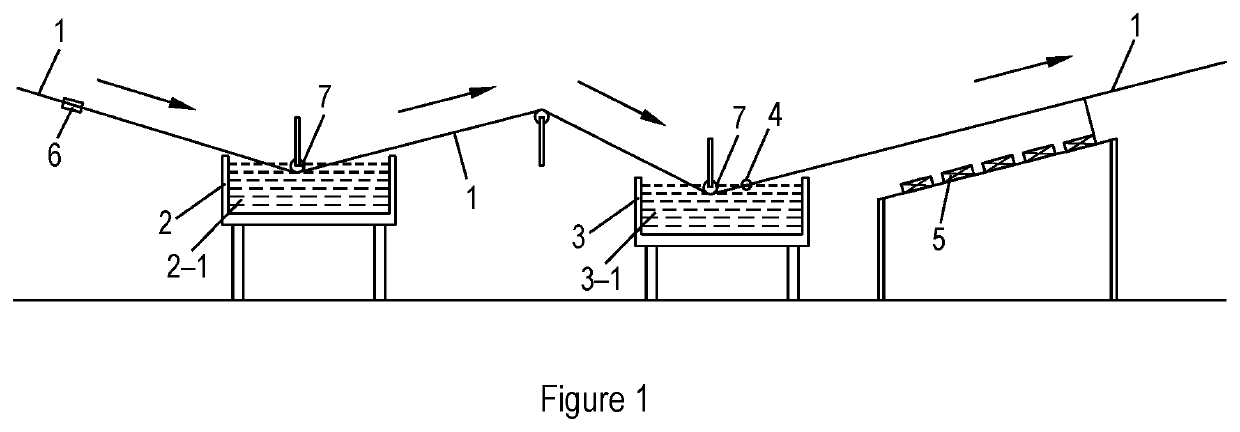Process for Producing Tinned Copper Wires
a technology of tinned copper wire and tinned copper, which is applied in the direction of manufacturing tools, welding/cutting media/materials, and manufacturing tools, etc., can solve the problems of reducing the wettability between the tin liquid and the local surface coating of tin, and reducing the wettability of the tin liquid. , the fluidity and wettability of the molten
- Summary
- Abstract
- Description
- Claims
- Application Information
AI Technical Summary
Benefits of technology
Problems solved by technology
Method used
Image
Examples
embodiment 1
[0046]Provided is a process for producing a tinned copper wire, as shown in FIG. 1, the steps of which are described as follows:
[0047]An annealed bare copper wire 1 having a diameter of 1.18 mm was selected, and conveyed at a speed of 180 m / min in a direction as indicated in FIG. 1 to start the process for tinning. Firstly, the copper wire was conveyed into a surface activation device 6 where activation treatment was carried out on the surface of the copper wire using ZnCl2 aqueous solution as a flux (purchased from Shenzhen Mingxinshun Technology Co., Ltd.). Then the copper wire was conveyed into a molten tin liquid 2-1 in a first hot tinning furnace 2 to receive a first hot tinning treatment. The copper wire was conveyed via a zirconia ceramic guide wheel 7, and there was no mold in the first hot tinning furnace. The molten tin liquid 2-1 had a temperature of 320° C. and comprised phosphorus in an amount of 0.1 wt %. Then the copper wire was conveyed out of the molten tin liquid i...
embodiment 2
[0049]Provided is a process for producing a tinned copper wire, the steps of which are described as follows:
[0050]An annealed bare copper wire 1 having a diameter of 0.49 mm was selected, and conveyed at a speed of 260 m / min in a direction as indicated in FIG. 1 to start the process for tinning. Firstly, the copper wire was conveyed into a surface activation device where activation treatment was carried out on the surface of the copper wire using ZnCl2 aqueous solution as a flux. Then the copper wire was conveyed into a molten tin liquid in a first hot tinning furnace to receive a first hot tinning treatment. The copper wire was conveyed via a zirconia ceramic guide wheel, and there was no mold in the first hot tinning furnace. The molten tin liquid had a temperature of 280° C. and comprised phosphorus in an amount of 0.08 wt %. Then the copper wire was conveyed out of the molten tin liquid in the first hot tinning furnace and exposed in natural air to undergo a first cooling by the...
embodiment 3
[0052]Provided is a process for producing a tinned copper wire, the steps of which are described as follows:
[0053]An annealed bare copper wire 1 having a diameter of 0.074 mm was selected, and conveyed at a speed of 350 m / min in a direction as indicated in FIG. 1 to start the process for tinning. Firstly, the copper wire was conveyed into a surface activation device where activation treatment was carried out on the surface of the copper wire using ZnCl2 aqueous solution as a flux. Then the copper wire was conveyed into a molten tin liquid in a first hot tinning furnace to receive a first hot tinning treatment. The copper wire was conveyed via a zirconia ceramic guide wheel, and there was no mold in the first hot tinning furnace. The molten tin liquid had a temperature of 270° C. and comprised phosphorus in an amount of 0.1 wt %. Then the copper wire was conveyed out of the molten tin liquid in the first hot tinning furnace and exposed in natural air to undergo a first cooling by the...
PUM
| Property | Measurement | Unit |
|---|---|---|
| temperature | aaaaa | aaaaa |
| temperature | aaaaa | aaaaa |
| temperature | aaaaa | aaaaa |
Abstract
Description
Claims
Application Information
 Login to View More
Login to View More - R&D
- Intellectual Property
- Life Sciences
- Materials
- Tech Scout
- Unparalleled Data Quality
- Higher Quality Content
- 60% Fewer Hallucinations
Browse by: Latest US Patents, China's latest patents, Technical Efficacy Thesaurus, Application Domain, Technology Topic, Popular Technical Reports.
© 2025 PatSnap. All rights reserved.Legal|Privacy policy|Modern Slavery Act Transparency Statement|Sitemap|About US| Contact US: help@patsnap.com

